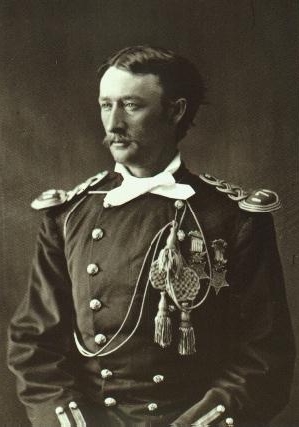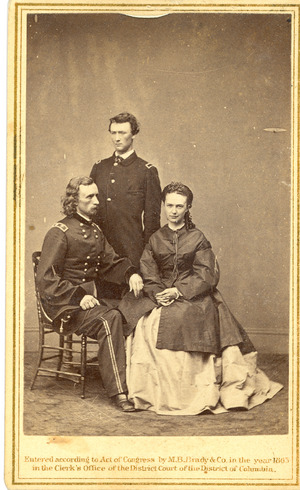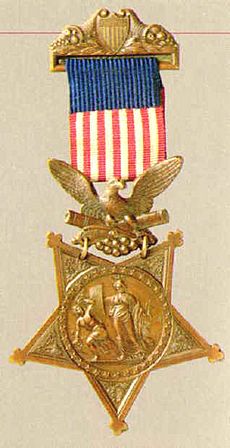Thomas Custer facts for kids
Quick facts for kids
Thomas Ward Custer
|
|
|---|---|

Captain Thomas W. Custer, two-time Medal of Honor recipient
|
|
| Born | March 15, 1845 New Rumley, Ohio |
| Died | June 25, 1876 (aged 31) Little Bighorn, Montana Territory |
| Buried | |
| Allegiance | Union |
| Service/ |
United States Army Union Army |
| Years of service | 1861–1876 |
| Rank | |
| Unit | 7th U.S. Cavalry Regiment |
| Commands held | Company C, 7th U.S. Cavalry |
| Battles/wars | |
| Awards | Medal of Honor (twice) |
Thomas Ward Custer (March 15, 1845 – June 25, 1876) was a brave officer in the United States Army. He received the Medal of Honor two times for his courage during the American Civil War. Thomas was the younger brother of George Armstrong Custer, a famous general.
He served as his brother's helper at the Battle of the Little Bighorn in Montana Territory. This battle was against the Lakota and Cheyenne tribes. Thomas, George, and their younger brother, Boston Custer, all died in this battle. It was a big defeat for the United States forces.
Contents
Early Life and Military Service

Thomas Custer was born in New Rumley, Ohio. He was the third son of Emanuel and Marie Custer. His family had German roots.
In September 1861, when he was just 16, Thomas joined the Union Army. He started as a private in the 21st Ohio Volunteer Infantry. He fought in many early battles of the Civil War. These included Stones River, Missionary Ridge, and the Atlanta Campaign.
He left the army in October 1864 as a corporal. Later, he became a second lieutenant in the 6th Michigan Cavalry. He then became an aide-de-camp (a personal assistant) to his brother, George Armstrong Custer. He stayed with his brother through the last year of the war.
Thomas Custer showed great bravery. He quickly moved up in rank, becoming a captain, major, and even a lieutenant colonel. He was only 20 years old when the Civil War ended. He was one of only 19 soldiers in history to receive the Medal of Honor twice.
Medals of Honor

Both times Thomas Custer earned the Medal of Honor, he captured enemy flags. These were flags from the Confederate army. He captured the 2nd North Carolina Cavalry flag at the Battle of Namozine Church on April 3, 1865. He did it again at the Battle of Sailor's Creek on April 6, 1865.
Battle flags were very important. They showed where units were fighting. Soldiers followed their flag in battle, even through noise and smoke. Losing a flag was a great dishonor for a unit.
First Medal of Honor
Custer earned his first Medal of Honor at the Battle of Namozine Church. This happened on April 3, 1865. Union soldiers were charging Confederate defenses. Custer rode his horse over a barricade while under enemy fire.
The Confederates were confused and fell back. Custer saw a soldier carrying a flag. He rode forward and grabbed the flag of the Second North Carolina cavalry. He then told the enemy soldiers around him to surrender. He captured three officers and eleven soldiers. His horse was shot, so he got a new one and took his prisoners back to his own lines.
Second Medal of Honor
Custer's actions at the Battle of Sailor's Creek earned him his second Medal of Honor. This made him the first American soldier to receive two Medals of Honor. He rode with Colonel Charles E. Capehart when they were ordered to charge.
He rode his horse through enemy gunfire toward their barricades. He jumped over the barricade and found himself surrounded by enemy soldiers. He fired his pistol, making the enemy scatter. He then saw Confederates trying to form a new battle line around a flag bearer. Custer charged the flag bearer.
After capturing the flag, Custer held it high. He rode back towards the Union lines. An officer tried to warn him to lower the flag so his own side wouldn't shoot him by mistake. But Custer kept riding. He rode to his brother George's battle flag and gave the captured flag to one of George's helpers. He said, "Armstrong, the rebels shot me, but I've got my flag."
Custer wanted to rejoin the fight. But his brother George ordered him to go to the doctor. Thomas ignored the order, so George put him under arrest and sent him to the back with a guard.
Service in the Indian Wars
After the Civil War, Custer became a first lieutenant in the 7th Cavalry in 1866. He was hurt during the Washita campaign in November 1868. This was part of the Indian Wars.
He later served with the Army during the Reconstruction period. His job was to help keep peace in South Carolina. He also went on the Yellowstone Expedition in 1873. During this trip, he fought in the Battle of Honsinger Bluff. He also joined the Black Hills Expedition in 1874.
In 1875, Custer became a captain. He was given command of Company C of the 7th Cavalry. In 1874, he helped arrest Chief Rain-in-the-Face (Lakota) at the Standing Rock Agency. The chief was suspected in a murder from 1873.
During the 1876 Battle of the Little Bighorn, Thomas Custer was a helper to his older brother, Lt. Col. George A. Custer. Thomas died with his brother on June 25, 1876. Their younger brother, Boston Custer, also died in the battle. Many other Custer family members and friends also died that day.
Thomas Custer was first buried on the battlefield. His body was later moved with other soldiers the next year. He was reburied in Fort Leavenworth National Cemetery. A stone marker shows where his body was first found and buried.
See also

